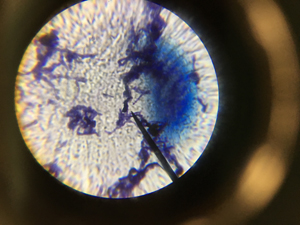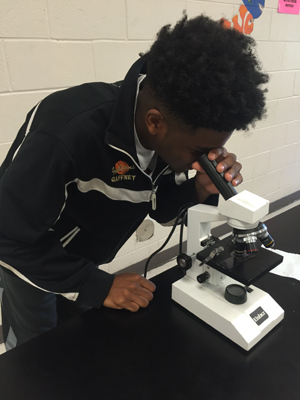Bacteria in Baumania

Sarah Fowler’s bacteria through microscope
November 9, 2016


Bacteria is multiplying all over every surface everywhere, but the awareness of this bacteria is not common because each multiplying organism is absolutely microscopic. Salmonella, Staphylococcus, Steptococcus, and E. coli are just a few of the most common bacteria that cause illnesses through normal every day contact. Farrah Bauman’s medical microbiology classes conducted a bacteria lab on October 28 to further understand the previous unit on epidemiology. Each student was able to become a scientist for the day, swab a surface, and watch bacteria grow.
“Through this lab I learned that even surfaces you would think to be completely clean are not.” –Molly Transou (Junior)
At the beginning of class on Friday, each student was given a sterile swab and then told to wet the swab so that bacteria from the swabbed surface would be picked up. Bauman let lose her scientists to swab the nook or corner they thought to be the dirtiest of all areas at Gaffney High School. Once the swab was contaminated with bacteria, the students returned to the classroom for further instructions. For every four students, there was one petri dish with four separate compartments. Each student used the smear method to transfer the bacteria from the swab to the agar. The petri dish was then placed upside down in an incubator after all students smeared their swabs.
The following Monday, each petri dish was removed from the incubator. Mrs. Bauman instructed her “microids” to put a drop of water on a glass slide, sterilize a metal loop tool with a flame, scrape a sample of bacteria from the agar, and mix the bacteria in with the water. Once the bacteria were properly mixed, carefully, the bacteria were heat fixed to the glass slide by holding the slide over the flame and letting the water “fry off.” Students then wiped off the BACK side of the slide to remove any black residue caused by the flame.
Tuesday, students were able to gram stain their bacteria and view the microscopic organisms through a light microscope. A gram stain is an extremely tedious process that takes alertness and patience. Each slide must be flooded with crystal violet, iodine, alcohol, and safranin; between each step, a certain amount of time must be allowed before the next step takes place. Once the gram stain was complete, the students were able to view their bacteria. The slides were carefully placed under the slide clips and the objective was turned to 10. Students then found the place on the slide where the gram stain was most evident; one drop of oil was then placed on that specific part of the slide. The objective was changed to 100, and the bacteria could then be identified by the students
Each student swabbed a different area of the school, so there was a great variety in the types of bacteria that were found. Dylan Martin, a junior in Bauman’s ninth period class, says he “swabbed the door handle of the front entrance to the school and found Staphylococcus at the end of the lab.” Vaidik Patel, another junior in Bauman’s ninth period class, found “Streptococcus when bacteria was cultured from the elevator button downstairs.” Sarah Fowler, a senior in Bauman’s seventh period class, found “Streptococcus from swabbing a dumbbell in the weight room.” Students found presumptive bacteria, so Bauman wants everyone to know that this lab is not an alarm to sound that Gaffney High School is contaminated. This lab simply proves the obvious, that bacteria is everywhere.
Through this lab, students were able to get a picture of what actually takes place in real labs. Proper safety, sanitation, etiquette, and procedure was demonstrated by Bauman to show her students the correct way to conduct a lab. This lab was an exciting but informative activity for Bauman’s “microids” to conduct.
“I enjoy doing this lab with my students because it shows them that bacteria can be grown from virtually any surface. Bacteria is everywhere no matter how clean you may think it is.” –Bauman

